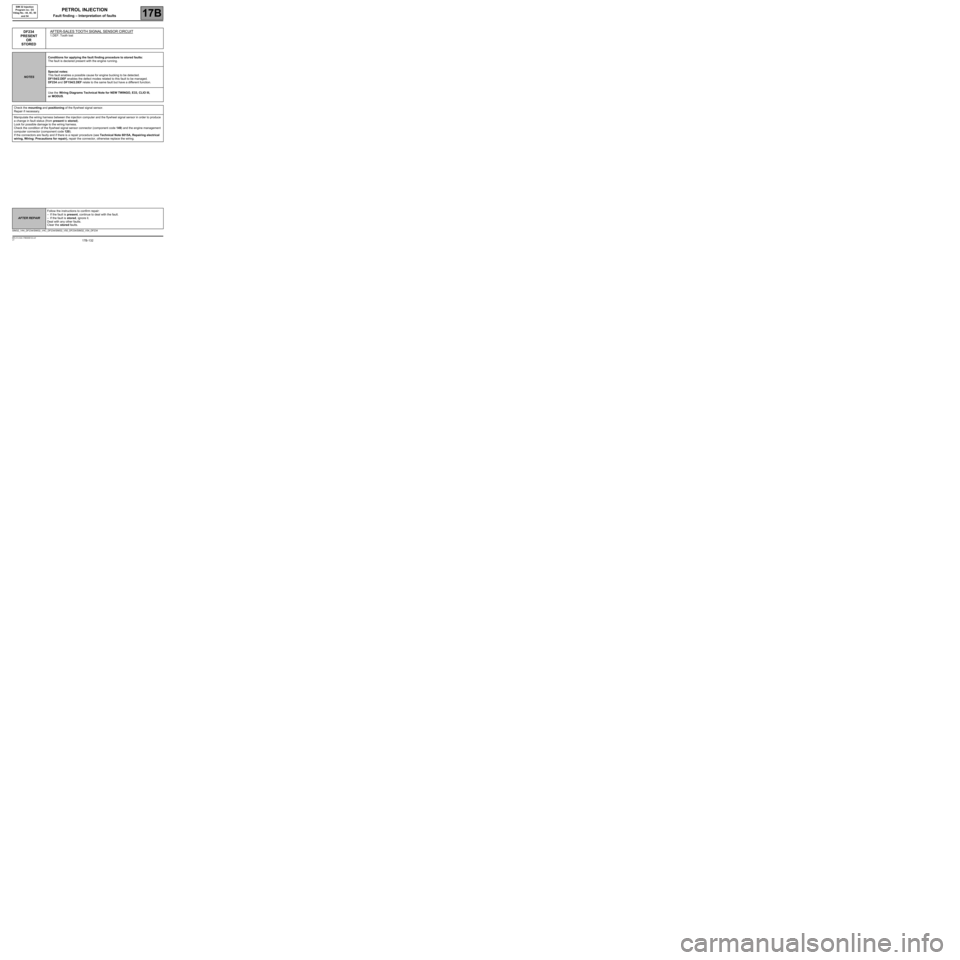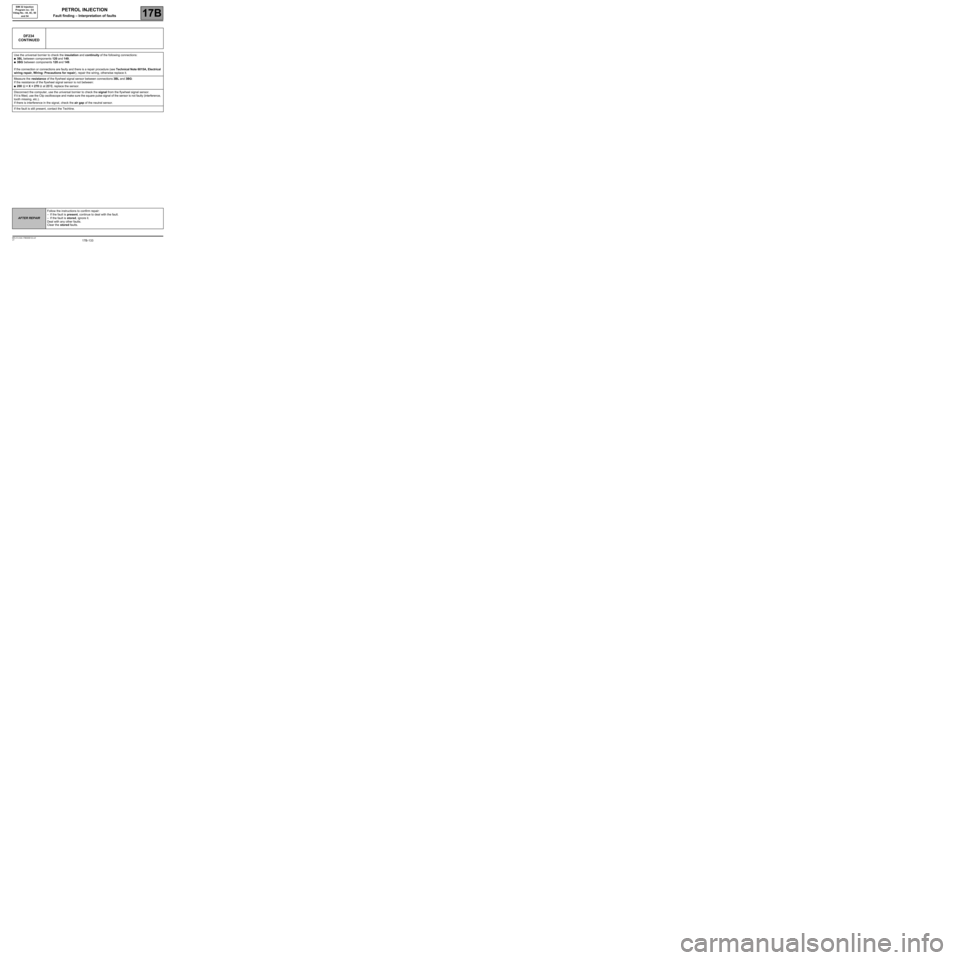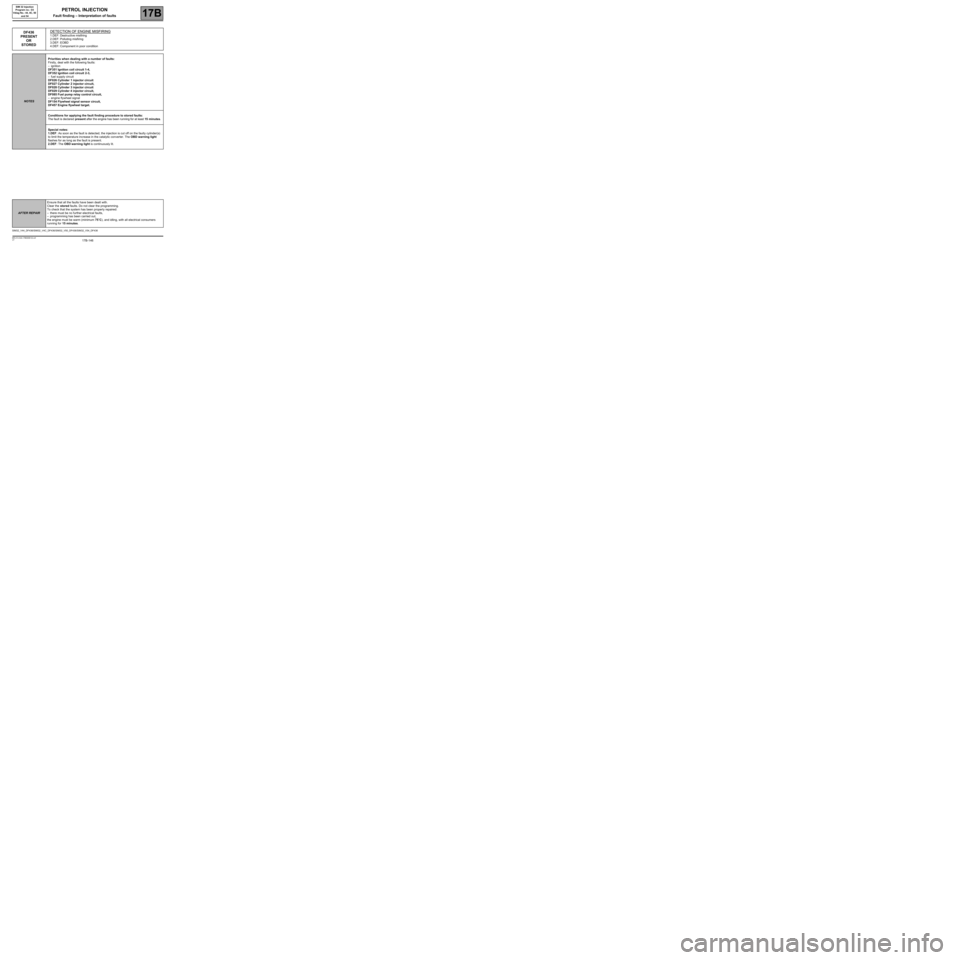2009 RENAULT TWINGO RS wheel
[x] Cancel search: wheelPage 105 of 348

17B-105V7 MR-413-X44-17B000$132.mif
PETROL INJECTION
Fault finding – Interpretation of faults17B
SIM 32 Injection
Program no.: D3
Vdiag No.: 44, 4C, 50
and 54
DF092
CONTINUED
Run command SC007 Run OBD Test: O2 sensors.
The aim of this scenario is to detect a fault causing the EOBD* threshold for pollutant emissions to be exceeded.
There are two kinds of oxygen sensor damage:
–mechanical damage to the component (breakage, cut in wire) which leads to an electrical fault,
–chemical or thermal damage to the component leading to a slower response time of the sensor and to the
increase in the average reaction time.
Before carrying out this test, repair all the electrical faults and clear the fault memory.
Deal first with the DF436 Misfiring detection fault and program the flywheel target ET089 Flywheel target
programming.
Perform this test when the engine is warm, which reduces the time it takes for the catalytic converter to heat up.
Fault finding is entirely autonomous. When completed, the throttle control ceases and the engine returns to idling
speed regulation operation.
At the end of this test, four different results are possible:
–status 1: Fault finding not carried out/impossible to establish the necessary conditions.
–status 2: Component in an average condition.
–status 3: Component in good condition.
–status 4: Component in poor condition.
When fault finding is completed and the result read, stop the engine and start it again to establish normal operating
conditions.
If the result is status 1: check for any faults, and the engine flywheel target programming using ET089
Programming engine flywheel target.
If the result is status 2 or status 4, replace the sensor.
If the result is status 3, the sensor is in good condition.
If the fault is still present, contact the Techline.
AFTER REPAIRIf the throttle valve has been replaced, program the throttle stops, RZ005 Programming.
Follow the instructions to confirm repair:
- If the fault is present, continue to deal with the fault.
- If the fault is stored, ignore it.
Deal with any other faults.
Clear the stored faults.
Page 115 of 348

17B-115V7 MR-413-X44-17B000$132.mif
PETROL INJECTION
Fault finding – Interpretation of faults17B
SIM 32 Injection
Program no.: D3
Vdiag No.: 44, 4C, 50
and 54
*RV/LV: Cruise control/speed limiter function
DF106
PRESENT
OR
STOREDCRUISE CONTROL - SPEED LIMITER SELECTOR SWITCH
ON
STEERING WHEEL
1. DEF: No signal
IMPORTANT:
To remove or check the cruise control - speed limiter control switches, the airbag must be removed
(see MR 392 (Clio III), MR 385 (MODUS), or MR 411 (New Twingo), or MR 442 (E33), Mechanical, 88C,
Airbag and pretensioners, Driver's frontal airbag, Removal - Refitting).
NOTESConditions for applying the fault finding procedure to stored faults
The fault is present after a road test using the cruise control then the speed
limiter function.
Use the Wiring Diagrams Technical Note for NEW TWINGO, E33, CLIO III,
or MODUS.
Check the cleanliness and condition of the incrementing switches on the steering wheel and their connections.
If the connectors are faulty and if there is a repair procedure (see Technical Note 6015A, Repairing electrical
wiring, Wiring: Precautions for repair), repair the connector, otherwise replace the wiring.
Disconnect the battery.
Disconnect the injection computer.
Check the cleanliness and condition of the injection computer connections, component code 120.
If the connector is faulty and there is a repair method (see Technical Note 6015A, Repairing electrical wiring,
Wiring: Precautions for repair), repair the connector, otherwise replace the wiring.
Using the Universal bornier, check for insulation and continuity on the following connections:
●86G between components 120 and 331,
●86M between components 120 and 331.
If the connection or connections are faulty and there is a repair procedure (see Technical Note 6015A, Electrical
wiring repair, Wiring: Precautions for repair), repair the wiring, otherwise replace it.
–If the fault is still present, contact the Techline.
SIM32_V44_DF106/SIM32_V4C_DF106/SIM32_V50_DF106/SIM32_V54_DF106
AFTER REPAIRFollow the instructions to confirm repair:
- If the fault is present, continue to deal with the fault.
- If the fault is stored, ignore it.
Deal with any other faults.
Clear the stored faults.
Page 124 of 348

17B-124V7 MR-413-X44-17B000$132.mif
PETROL INJECTION
Fault finding – Interpretation of faults17B
SIM 32 Injection
Program no.: D3
Vdiag No.: 44, 4C, 50
and 54
DF154
PRESENT
OR
STOREDFLYWHEEL SIGNAL SENSOR CIRCUIT
1. DEF: Abnormal voltage
2.DEF: Tooth lost
3.DEF: EOBD
NOTESConditions for applying the fault finding procedure to stored faults:
The fault is considered present when the engine is running.
Special notes:
In the event of flywheel signal loss, the injection and ignition are cut off: the vehicle stalls
and cannot be restarted.
Use the Wiring Diagrams Technical Note for NEW TWINGO, E33, CLIO III,
or MODUS.
Check the mounting and positioning of the flywheel signal sensor.
Repair if necessary.
Manipulate the wiring harness between the injection computer and the flywheel signal sensor in order to produce
a change in fault status (from present to stored).
Look for possible damage to the wiring harness.
Check the condition of the connector of the flywheel signal sensor (component code 149) and of the engine
management computer (component code 120).
If the connectors are faulty and if there is a repair procedure (see Technical Note 6015A, Repairing electrical
wiring, Wiring: Precautions for repair), repair the connector, otherwise replace the wiring.
Use the universal bornier to check the insulation and continuity of the following connections:
●3BL between components 120 and 149,
●3BG between components 120 and 149.
If the connection or connections are faulty and there is a repair procedure (see Technical Note 6015A, Electrical
wiring repair, Wiring: Precautions for repair), repair the wiring, otherwise replace it.
SIM32_V44_DF154/SIM32_V4C_DF154/SIM32_V50_DF154/SIM32_V54_DF154
AFTER REPAIRFollow the instructions to confirm repair:
- If the fault is present, continue to deal with the fault.
- If the fault is stored, ignore it.
Deal with any other faults.
Clear the stored faults.
Page 125 of 348

17B-125V7 MR-413-X44-17B000$132.mif
PETROL INJECTION
Fault finding – Interpretation of faults17B
SIM 32 Injection
Program no.: D3
Vdiag No.: 44, 4C, 50
and 54
DF154
CONTINUED
Measure the resistance of the flywheel signal sensor between connections 3BL and 3BG:
If the resistance of the flywheel signal sensor is not between:
200
Ω < X < 270 Ω at 23 ˚C, replace the sensor.
Disconnect the computer, use the universal bornier to check the signal from the flywheel signal sensor.
If it is fitted, use the Clip oscilloscope and make sure the square pulse signal of the sensor is not faulty (interference,
tooth missing, etc.).
If there is interference in the signal, check the air gap of the TDC sensor.
If the fault is still present, contact the Techline.
AFTER REPAIRFollow the instructions to confirm repair:
- If the fault is present, continue to deal with the fault.
- If the fault is stored, ignore it.
Deal with any other faults.
Clear the stored faults.
Page 132 of 348

17B-132V7 MR-413-X44-17B000$133.mif
PETROL INJECTION
Fault finding – Interpretation of faults17B
SIM 32 Injection
Program no.: D3
Vdiag No.: 44, 4C, 50
and 54
DF234
PRESENT
OR
STOREDAFTER-SALES TOOTH SIGNAL SENSOR CIRCUIT
1.DEF: Tooth lost
NOTESConditions for applying the fault finding procedure to stored faults:
The fault is declared present with the engine running.
Special notes:
This fault enables a possible cause for engine bucking to be detected.
DF154/2.DEF enables the defect modes related to this fault to be managed.
DF234 and DF154/2.DEF relate to the same fault but have a different function.
Use the Wiring Diagrams Technical Note for NEW TWINGO, E33, CLIO III,
or MODUS.
Check the mounting and positioning of the flywheel signal sensor.
Repair if necessary.
Manipulate the wiring harness between the injection computer and the flywheel signal sensor in order to produce
a change in fault status (from present to stored).
Look for possible damage to the wiring harness.
Check the condition of the flywheel signal sensor connector (component code 149) and the engine management
computer connector (component code 120).
If the connectors are faulty and if there is a repair procedure (see Technical Note 6015A, Repairing electrical
wiring, Wiring: Precautions for repair), repair the connector, otherwise replace the wiring.
SIM32_V44_DF234/SIM32_V4C_DF234/SIM32_V50_DF234/SIM32_V54_DF234
AFTER REPAIRFollow the instructions to confirm repair:
–If the fault is present, continue to deal with the fault.
–If the fault is stored, ignore it.
Deal with any other faults.
Clear the stored faults.
Page 133 of 348

17B-133V7 MR-413-X44-17B000$133.mif
PETROL INJECTION
Fault finding – Interpretation of faults17B
SIM 32 Injection
Program no.: D3
Vdiag No.: 44, 4C, 50
and 54
DF234
CONTINUED
Use the universal bornier to check the insulation and continuity of the following connections:
●3BL between components 120 and 149,
●3BG between components 120 and 149.
If the connection or connections are faulty and there is a repair procedure (see Technical Note 6015A, Electrical
wiring repair, Wiring: Precautions for repair), repair the wiring, otherwise replace it.
Measure the resistance of the flywheel signal sensor between connections 3BL and 3BG:
If the resistance of the flywheel signal sensor is not between:
●200 Ω < X < 270 Ω at 23˚C, replace the sensor.
Disconnect the computer, use the universal bornier to check the signal from the flywheel signal sensor.
If it is fitted, use the Clip oscilloscope and make sure the square pulse signal of the sensor is not faulty (interference,
tooth missing, etc.).
If there is interference in the signal, check the air gap of the neutral sensor.
If the fault is still present, contact the Techline.
AFTER REPAIRFollow the instructions to confirm repair:
–If the fault is present, continue to deal with the fault.
–If the fault is stored, ignore it.
Deal with any other faults.
Clear the stored faults.
Page 142 of 348

17B-142V7 MR-413-X44-17B000$133.mif
PETROL INJECTION
Fault finding – Interpretation of faults17B
SIM 32 Injection
Program no.: D3
Vdiag No.: 44, 4C, 50
and 54
DF394
PRESENT
OR
STOREDCATALYTIC CONVERTER OPERATING FAULT
1.DEF: Component in bad condition
2.DEF: EOBD
NOTESPriorities when dealing with a number of faults:
Deal with any other fault first.
Conditions for applying the fault finding procedure to stored faults:
The fault is declared present after the engine starts.
Special notes:
The OBD warning light is lit.
Use the Wiring Diagrams Technical Note for NEW TWINGO, E33, CLIO III,
or MODUS.
Only for Vdiag 4C, 50 and 54
Check the appearance and condition of the catalytic converter. Check there are no air leaks, thermal shock,
misfiring, coolant or oil consumption.
Run command SC006 Running OBD Test: catalytic converter. Before carrying out this test, repair all the
electrical faults and clear the fault memory. Check that fault DF436 Misfiring detection is not present and program
the engine flywheel target ET089 Flywheel target programming.
Carry out this test when the engine is warm, which reduces the time it takes for the catalytic converter to heat up.
At the end of this test, four different results are possible:
–Status 1: Fault finding not carried out/impossible to obtain the necessary conditions.
–Status 2: Component in an average condition.
–Status 3: Component in good condition.
–Status 4: Component in poor condition.
When fault finding is completed and the result read, stop the engine and start it again to establish normal operating
conditions.
If the result is status 1: check that there are no faults, and check the engine flywheel target programming using
ET089 Programming engine flywheel target.
If the result is status 2 or 4: replace the catalytic converter.
If the result is status 3: the catalytic converter is in good condition.
If the fault is still present, contact the Techline.
SIM32_V44_DF394/SIM32_V4C_DF394/SIM32_V50_DF394/SIM32_V54_DF394
AFTER REPAIREnsure that all the faults have been dealt with.
Clear the stored faults. Do not clear the programming.
To check that the system has been properly repaired:
–there must be no further electrical faults,
–programming has been carried out,
the engine must be warm (minimum 75˚C), and idling, with all electrical consumers
running for 15 minutes.
Page 146 of 348

17B-146V7 MR-413-X44-17B000$133.mif
PETROL INJECTION
Fault finding – Interpretation of faults17B
SIM 32 Injection
Program no.: D3
Vdiag No.: 44, 4C, 50
and 54
DF436
PRESENT
OR
STOREDDETECTION OF ENGINE MISFIRING1.DEF: Destructive misfiring
2.DEF: Polluting misfiring
3.DEF: EOBD
4.DEF: Component in poor condition
NOTESPriorities when dealing with a number of faults:
Firstly, deal with the following faults:
–ignition
DF351 Ignition coil circuit 1-4,
DF352 Ignition coil circuit 2-3,
–fuel supply circuit
DF026 Cylinder 1 injector circuit
DF027 Cylinder 2 injector circuit,
DF028 Cylinder 3 injector circuit
DF029 Cylinder 4 injector circuit,
DF085 Fuel pump relay control circuit,
–engine flywheel signal
DF154 Flywheel signal sensor circuit,
DF457 Engine flywheel target.
Conditions for applying the fault finding procedure to stored faults:
The fault is declared present after the engine has been running for at least 15 minutes.
Special notes:
1.DEF: As soon as the fault is detected, the injection is cut off on the faulty cylinder(s)
to limit the temperature increase in the catalytic converter. The OBD warning light
flashes for as long as the fault is present.
2.DEF: The OBD warning light is continuously lit.
SIM32_V44_DF436/SIM32_V4C_DF436/SIM32_V50_DF436/SIM32_V54_DF436
AFTER REPAIREnsure that all the faults have been dealt with.
Clear the stored faults. Do not clear the programming.
To check that the system has been properly repaired:
–there must be no further electrical faults,
–programming has been carried out,
the engine must be warm (minimum 75˚C), and idling, with all electrical consumers
running for 15 minutes.